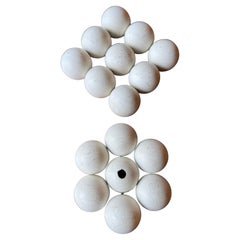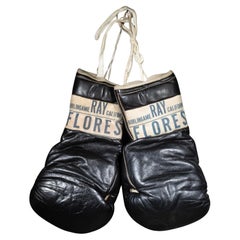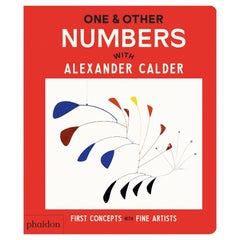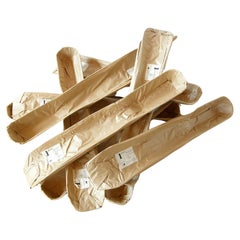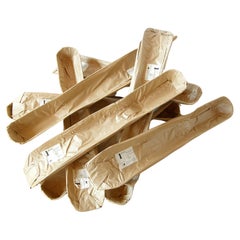Charles and Ray Eames Scientific Instruments
Charles Eames and Ray Eames were the embodiment of the inventiveness, energy and optimism at the heart of mid-century modern American design, and have been recognized as the most influential designers of the 20th century. The Eameses were lovers of folk craft who had a genius for making highly original chairs, tables, case pieces and other furniture using traditional materials and forms.
As furniture designers, filmmakers, artists, textile and graphic designers and even toy and puzzle makers, the Eameses were a visionary and effective force for the notion that design should be an agent of positive change. They are the happy, ever-curious, ever-adventurous faces of modernism.
Charles Eames (1907–78) studied architecture and industrial design. Ray Eames (née Beatrice Alexandra Kaiser, 1912–88) was an artist, who studied under the Abstract Expressionist painter Hans Hofmann. They met in 1940 at the Cranbrook Academy of Art in suburban Detroit (the legendary institution where Charles also met his frequent collaborator Eero Saarinen and the artist and designer Harry Bertoia) and married the next year.
His technical skills and her artistic flair were wonderfully complementary. They moved to Los Angeles in 1941, where Charles worked on set design for MGM. In the evenings at their apartment, they experimented with molded plywood using a handmade heat-and-pressurization device they called the “Kazam!” machine. The next year, they won a contract from the U.S. Navy for lightweight plywood leg splints for wounded servicemen — vintage Eames splints are coveted collectibles today; more so those that Ray used to make sculptures.
The Navy contract allowed Charles to open a professional studio, and the attention-grabbing plywood furniture the firm produced prompted George Nelson, the director of design of the furniture-maker Herman Miller Inc., to enlist Charles and (by association, if not by contract) Ray in 1946. Some of the first Eames items to emerge from Herman Miller are now classics: the Eames chair, the LCW, or Lounge Chair Wood, and the DCM, or Dining Chair Metal, supported by tubular steel.
The Eameses eagerly embraced new technology and materials, and one of their peculiar talents was to imbue their supremely modern design with references to folk traditions.
Their Wire chair group of the 1950s, for example, was inspired by basket weaving techniques. The populist notion of “good design for all” drove their molded fiberglass chair series that same decade, and also produced the organic-form, ever-delightful La Chaise. In 1956 the Eames lounge chair and ottoman appeared — the supremely comfortable plywood-base-and-leather-upholstery creation that will likely live in homes as long as there are people with good taste and sense.
Charles Eames once said, “The role of the designer is that of a very good, thoughtful host anticipating the needs of his guests.” For very good collectors and thoughtful interior designers, a piece of design by the Eameses, the closer produced to original conception the better, is almost de rigueur — for its beauty and comfort, and not least as a tribute to the creative legacy and enduring influence of Charles and Ray Eames.
The original Eames furniture for sale on 1stDibs includes chairs, tables, case pieces and other items.
1960s American Mid-Century Modern Vintage Charles and Ray Eames Scientific Instruments
Stone
Mid-20th Century American Industrial Charles and Ray Eames Scientific Instruments
Leather
2010s Chinese Charles and Ray Eames Scientific Instruments
Paper
Early 1800s French Empire Antique Charles and Ray Eames Scientific Instruments
Paper, Wood
21st Century and Contemporary American Charles and Ray Eames Scientific Instruments
Paper
1950s Mid-Century Modern Vintage Charles and Ray Eames Scientific Instruments
Paper
1940s American Vintage Charles and Ray Eames Scientific Instruments
Birch
1960s American Vintage Charles and Ray Eames Scientific Instruments
Resin
Mid-20th Century Central American Mid-Century Modern Charles and Ray Eames Scientific Instruments
Plywood
Late 20th Century American Mid-Century Modern Charles and Ray Eames Scientific Instruments
Steel
Mid-20th Century English Sporting Art Charles and Ray Eames Scientific Instruments
Wool
17th Century French Antique Charles and Ray Eames Scientific Instruments
Paper
1790s French Other Antique Charles and Ray Eames Scientific Instruments
Wood, Paper
1940s American Mid-Century Modern Vintage Charles and Ray Eames Scientific Instruments
Plywood
1940s American Mid-Century Modern Vintage Charles and Ray Eames Scientific Instruments
Plywood
1940s American Mid-Century Modern Vintage Charles and Ray Eames Scientific Instruments
Plywood
1940s American Mid-Century Modern Vintage Charles and Ray Eames Scientific Instruments
Plywood
1940s American Mid-Century Modern Vintage Charles and Ray Eames Scientific Instruments
Plywood
1940s American Mid-Century Modern Vintage Charles and Ray Eames Scientific Instruments
Plywood
1940s American Mid-Century Modern Vintage Charles and Ray Eames Scientific Instruments
Plywood
1940s American Mid-Century Modern Vintage Charles and Ray Eames Scientific Instruments
Plywood
1940s American Mid-Century Modern Vintage Charles and Ray Eames Scientific Instruments
Plywood
1940s American Mid-Century Modern Vintage Charles and Ray Eames Scientific Instruments
Plywood
1940s American Mid-Century Modern Vintage Charles and Ray Eames Scientific Instruments
Plywood
1940s American Mid-Century Modern Vintage Charles and Ray Eames Scientific Instruments
Plywood
Charles And Ray Eames scientific instruments for sale on 1stDibs.
- 1stDibs ExpertFebruary 21, 2024Charles and Ray Eames were related by marriage. Charles studied architecture and industrial design. Ray (née Bernice Alexandra Kaiser) was an artist who studied under painter Hans Hofmann. They met in 1940 at the Cranbrook Academy of Art in suburban Detroit and married the next year. Shop a selection of Charles and Ray Eames furniture on 1stDibs.
- 1stDibs ExpertApril 5, 2022Charles and Ray Eames are famous for their chair designs. The couple released their first iconic Eames Lounge and Ottoman in 1956 and went on to create more chairs that changed the idea of comfortable seating. In addition to being great furniture designers, Ray and Charles were also graphic and textile designers, architects and film-makers. Shop a collection of Eames chairs from some of the world’s top sellers on 1stDibs.
- 1stDibs ExpertApril 5, 2022Charles and Ray Eames have been recognized as the 20th century’s most influential designers and are best known for their highly recognizable chairs. The Eames lounge chair and ottoman are an iconic duo in modern-styled furniture, and some of the first Eames items to emerge from Herman Miller are now classics: the LCW, or Lounge Chair Wood, and the DCM, or Dining Chair Metal, supported by tubular steel. Find vintage Charles and Ray Eames furniture on 1stDibs.
- 1stDibs ExpertApril 5, 2022For Charles and Ray Eames’ chairs designed for Herman Miller, molded plywood, fiberglass-reinforced plastic, bent and welded wire mesh, and cast aluminum were used in production. You can shop a collection of Eames furniture from some of the world’s top sellers on 1stDibs.
- 1stDibs ExpertApril 5, 2022Rosewood was the favorite wood of famed American designers Charles and Ray Eames. Rosewood made its way into some of the duo’s most celebrated designs, including the iconic Eames lounge chair. On 1stDibs, you’ll find a collection of genuine Eames furniture from some of the world’s top sellers.
- 1stDibs ExpertApril 5, 2024Yes, Charles Eames chairs are comfortable. The Eameses — Charles and Ray — were fascinated by ergonomics and designed chairs with comfort in mind. The legendary mid-century modernist designer-couple famously called their Eames lounge chair and ottoman “a special refuge from the strains of modern living” and described their design as having the “warm receptive look of a well-used first baseman’s mitt.”
While the couple’s DCW chairs, introduced in the 1940s, prioritized ease of production and affordability of materials, the Eames lounger, which debuted in 1956, was Charles and Ray’s interpretation of luxury furniture. And to the Eameses, luxury meant, above all, comfort.
Find vintage Charles and Ray Eames furniture on 1stDibs.
